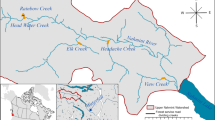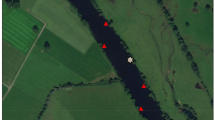Abstract
Estuaries are used by anadromous fishes, either as the definitive marine habitat or as transition habitat as they move to fully marine waters, and extent of estuary use may vary with habitat conditions and fish attributes. Bull trout (Salvelinus confluentus) are commonly fluvial or adfluvial, though anadromous populations also exist. However, little is known about estuary use, especially by juveniles of this threatened species. We sampled the estuaries of the Elwha River, where a spawning population exists, and the nearby Salt Creek, where none exists, to reveal seasonal timing of estuarine use by juvenile bull trout, size of those using the estuary, and possible use of the non-natal estuary. We captured juvenile bull trout (all ≥100 mm FL, most <300 mm) in the Elwha River estuary in all months except August, but primarily December through May. None was captured in Salt Creek’s estuary despite comparable sampling effort. We also evaluated how dam removal on the Elwha River influenced bull trout estuarine occupancy by sampling before, during, and after dam removal, because this process enlarged the estuary but also increased turbidity and sediment transport in the lower river. Catches were low before dam removal, increased during and immediately after removal, and returned to low levels in recent years, suggesting that juveniles temporarily sought refuge from conditions associated with dam removal. Our findings indicate juvenile bull trout occupy estuarine habitat opportunistically; this information may aid conservation efforts as anadromous populations occur elsewhere in rivers with estuaries altered by human development.




Similar content being viewed by others
References
Baker RR (1978) The evolutionary ecology of animal migration. Holmes and Meier, New York
Bates D, Mächler M, Bolker B, Walker S (2015) Fitting linear mixed-effects models using lme4. J Stat Softw 67:1–48
Beamer E, Henderson R, Wolf K (2004) Bull trout use of Swinomish reservation waters. Report prepared for Skagit River System Cooperative, La Conner, p 10
Bond MH, Miller JA, Quinn TP (2015) Beyond dichotomous life histories in partially migrating populations: cessation of anadromy in a long-lived fish. Ecology 96:1899–1910
Brenkman SJ, Corbett SC (2005) Extent of anadromy in bull trout and implications for conservation of a threatened species. North Am J Fish Manag 25:1073–1081
Brenkman SJ, Corbett SC, Volk EC (2007) Use of otolith chemistry and radiotelemetry to determine age-specific migratory patterns of anadromous bull trout in the Hoh River, Washington. Trans Am Fish Soc 136:1–11
Brenkman SJ, Pess GR, Torgersen CE et al (2008) Predicting recolonization patterns and interactions between potamodromous and anadromous salmonids in response to dam removal in the Elwha River, Washington state, USA. Northwest Sci 82:91–106
Brenkman SJ, Duda JJ, Torgersen CE, Welty E, Pess GR, Peters R, McHenry ML (2012) A riverscape perspective of Pacific salmonids and aquatic habitats prior to large-scale dam removal in the Elwha River, Washington, USA. Fish Manag Ecol 19:36–53
DeHaan PW, Brenkman SJ, Adams B, Crain P (2011) Genetic population structure of Olympic peninsula bull trout populations and implications for Elwha dam removal. Northwest Sci 85:463–475
Dingle H (1996) Migration: the biology of life on the move. Oxford University Press, New York
Duda JJ, Freilich JE, Schreiner EG (2008) Baseline studies in the Elwha River ecosystem prior to dam removal: introduction to the special issue. Northwest Sci 82:1–12
Dunham J, Baxter C, Fausch K et al (2008) Evolution, ecology, and conservation of Dolly Varden, white spotted char, and bull trout. Fisheries 33:537–550
Foley MM, Duda JJ, Beirne MM et al (2015) Rapid water quality change in the Elwha River estuary complex during dam removal. Limnol Oceanogr 60:1719–1732
Foley MM, Warrick JA, Ritchie A et al (2017) Coastal habitat and biological community response to dam removal on the Elwha River. Ecol Monogr 87:552–577
Gelfenbaum G, Stevens AW, Miller I et al (2015) Large-scale dam removal on the Elwha River, Washington, USA: coastal geomorphic change. Geomorphology 246:649–668
Goetz FA (2016) Migration and residence patterns of salmonids in Puget Sound, Washington. Ph.D. thesis, University of Washington, p 187
Goetz FA, Jeanes E, Beamer E (2004) Bull trout in the nearshore. Draft Report by US Army Corps of Engineers, Seattle, p 143
Hayes MC, Rubin SP, Reisenbichler RR et al (2011) Marine habitat use by anadromous bull trout from the Skagit River, Washington. Mar Coast Fish 3:394–410
Heggenes J (1988) Effects of short-term flow fluctuations on displacement of, and habitat use by, brown trout in a small stream. Trans Am Fish Soc 117:336–344
Heggenes J, Traaen T (1988) Downstream migration and critical water velocities in stream channels for fry of four salmonid species. J Fish Biol 32:717–727
Hendry AP, Bohlin T, Jonsson B, Berg OK (2004) To sea or not to sea? Anadromy versus non-anadromy in salmonids. In: Hendry AP, Stearns SC (eds) Evolution illuminated, 1st edn. Oxford University Press, New York, pp 92–125
Holtby LB, Scrivener JC (1989) Observed and simulated effects of climatic variability, clear-cut logging, and fishing on the numbers of chum salmon (Oncorhynchus keta) and coho salmon (O. kisutch) returning to Carnation Creek, British Columbia. Can Spec Publ Fish Aquat Sci 105:62–81
Jensen JLA, Rikardsen AH (2008) Do northern riverine anadromous Arctic charr Salvelinus alpinus and sea trout Salmo trutta overwinter in estuarine and marine waters? J Fish Biol 73:1810–1818
Losee JP, Phillips L, Young WC (2016) Spawn timing and redd morphology of anadromous coastal cutthroat trout Oncorhynchus clarkii clarkii in a tributary of South Puget Sound, Washington. North Am J Fish Manag 36:375–384
McCormick SD (1994) Ontogeny and evolution of salinity tolerance in anadromous salmonids: hormones and heterochrony. Estuaries 17:26–33
McDowall RM (1988) Diadromy in fishes: migrations between freshwater and marine environments. Croom Helm, London
McHenry M, McCoy R, Haggerty M (2004) Salt Creek watershed: an assessment of habitat conditions, fish populations and opportunities for restoration. Report to North Olympic Salmon Coalition, Port Townsend, p 118
Morita K (2001) The growth history of anadromous white-spotted charr in northern Japan: a comparison between river and sea life. J Fish Biol 59:1556–1565
Otero J, L’Abée-Lund JH, Castro-Santos T et al (2014) Basin-scale phenology and effects of climate variability on global timing of initial seaward migration of Atlantic salmon (Salmo salar). Glob Chang Biol 20:61–75
Paragamian VL, Walters JP (2011) Bull trout (Salvelinus confluentus) movement in a transboundary river. J Freshw Ecol 26:65–76
Pavlov DS, Savvaitova KA (2008) On the problem of ratio of anadromy and residence in salmonids (Salmonidae). J Ichthyol 48:778–791
Pess GR, McHenry ML, Beechie TJ, Davies J (2008) Biological impacts of the Elwha River dams and potential salmonid responses to dam removal. Northwest Sci 82:72–90
Quinn TP (2005) The behavior and ecology of Pacific salmon and trout. University of Washington Press, Seattle
Quinn TP, Myers KW (2004) Anadromy and the marine migrations of Pacific salmon and trout: Rounsefell revisited. Rev Fish Biol Fish 14:421–442
Quinn TP, Harris N, Shaffer JA et al (2013) Juvenile coho salmon in the Elwha River estuary prior to dam removal: seasonal occupancy, size distribution, and comparison to nearby Salt Creek. Trans Am Fish Soc 142:1058–1066
Quinn TP, Bond MH, Brenkman SJ et al (2017) Re-awakening dormant life history variation: stable isotopes indicate anadromy in bull trout following dam removal on the Elwha River, Washington. Environ Biol Fish 100:1659–1671
R Core Development Team (2017) R: a language and environment for statistical computing. R Foundation for Statistical Computing, Vienna
Randall R, Healey M, Dempson J (1987) Variability in length of freshwater residence of salmon, trout, and char. In: Dodswell MJ, Klauda RJ, Moffitt CM et al (eds) Common strategies of anadromous and catadromous fishes. American Fisheries Society, Bethesda, pp 27–41
Roni P, Bennett T, Holland R, Pess G, Hanson K, Moses R, McHenry M, Ehinger W, Walter J (2012) Factors affecting migration timing, growth, and survival of juvenile coho salmon in two coastal Washington watersheds. Trans Am Fish Soc 141:890–906
Rounsefell GA (1958) Anadromy in north American Salmonidae. Fish Bull 131:171–185
Rubin SP, Miller IM, Foley MM et al (2017) Increased sediment load during a large-scale dam removal changes nearshore subtidal communities. PLoS One 12:e0187742
Samarasin P, Shuter BJ, Rodd FH (2017) After 100 years: hydroelectric dam-induced life-history divergence and population genetic changes in sockeye salmon (Oncorhynchus nerka). Conserv Genet 18:1449–1462
Shaffer JA, Higgs E, Walls C, Juanes F (2017a) Large-scale dam removals and nearshore ecological restoration: lessons learned from the Elwha dam removals. Ecol Restor 35:87–101
Shaffer JA, Juanes F, Quinn TP et al (2017b) Nearshore fish community responses to large scale dam removal: implications for watershed restoration and fish management. Aquat Sci 79:643–660
Simenstad CA, Fresh KL, Salo EO (1982) The role of Puget Sound estuaries in the life history of Pacific salmon: an unappreciated function. In: Kennedy VS (ed) Estuarine comparisons. Academic Press, New York, pp 343–364
Simenstad CA, Ramirez M, Burke J, Logsdon M, et al (2011) Historical change and impairment of Puget Sound shorelines: atlas and interpretation of Puget Sound nearshore ecosystem restoration project change analysis. Puget Sound nearshore ecosystem restoration project report no. 2011-01 by Washington Department of Fish and Wildlife and US Army Corps of Engineers, Olympia, p 289
Sloat MR, Fraser DJ, Dunham JB et al (2014) Ecological and evolutionary patterns of freshwater maturation in Pacific and Atlantic salmonines. Rev Fish Biol Fish 24:689–707
Spence BC, Hall JD (2010) Spatiotemporal patterns in migration timing of coho salmon (Oncorhynchus kisutch) smolts in North America. Can J Fish Aquat Sci 67:1316–1334
Tschaplinski PJ (2000) The effects of forest harvesting, fishing, climate variation, and ocean conditions on salmonid populations of Carnation Creek, Vancouver Island, British Columbia. In: Knudsen EE, Steward CR, MacDonald DD, Williams JE, Reiser DW (eds) Sustainable fisheries management: Pacific salmon. CRC Press, Boca Raton, pp 297–327
Warrick JA, Bountry JA, East AE et al (2015) Large-scale dam removal on the Elwha River, Washington, USA: source-to-sink sediment budget and synthesis. Geomorphology 246:729–750
Wood CC, Foote CJ (1996) Evidence for sympatric genetic divergence of anadromous and nonanadromous morphs of sockeye salmon (Oncorhynchus nerka). Evolution 50:1265–1279
Zimmerman M, Kinsel C (2010) Migration of anadromous juvenile bull trout in the Skagit River, 1990-2009. FPT 11-01 report by Washington Department of Fish and Wildlife, Olympia, p 48
Acknowledgements
We thank the many individuals that helped in sampling, including Marisa Christopher, Joshua Davis, David Harvey, Tony Thompson, Seren Weber, Mike Mille, Sheri Washington, Lauren Kerr, Tara McBride, Jamie Michel, Ellie Stevenson, Chris Byrnes, Dave Parks and many volunteers: John Anderson, Normandie Anderson, Catherine Austin, Dave Christian, Elizabeth Christian, and Washington Conservation Corps crew Pete Allen, Nate Indresano, Samantha Miller, and Allie Vitello. We also acknowledge our collaborators Francis Juanes, Bruce Hattendorf, Dwight Barry, Jack Ganzhorn, Barb Blackie, and Nancy Bluestien-Johnson. The Elwha dam removal project occurred due to the tenacity of the members and staff of the Lower Elwha Klallam Tribe, including Rob Elofson and Russ Bush, as well as Brian Winter and local and national staff of the National Park Service and Olympic National Park.
Funding
This work was funded by the United States Environmental Protection Agency under assistance agreement PC00J29801 to Washington Department of Fish and Wildlife, the Coastal Watershed Institute, Patagonia, the Olympic Peninsula Surfrider Foundation, the Rose Foundation, the Seattle Foundation, the Hayes Foundation, the Puget Soundkeeper Alliance, the Clallam Marine Resources Committee, the University of Victoria, and the University of Washington. Participation by AL and TQ was supported by the Washington Sea Grant program, University of Washington, pursuant to National Oceanic and Atmospheric Administration Award No. NA10OAR4170075, Project R/LME-7, and also by the H. Mason Keeler and the Richard and Lois Worthington endowments at the University of Washington.
Author information
Authors and Affiliations
Corresponding author
Ethics declarations
Conflict of interest
The authors declare that they have no conflict of interest.
Ethical approval
All applicable national and institutional guidelines for the care and use of animals were followed.
Rights and permissions
About this article
Cite this article
Lincoln, A.E., Shaffer, J.A. & Quinn, T.P. Opportunistic use of estuarine habitat by juvenile bull trout, Salvelinus confluentus, from the Elwha River before, during, and after dam removal. Environ Biol Fish 101, 1559–1569 (2018). https://doi.org/10.1007/s10641-018-0800-9
Received:
Accepted:
Published:
Issue Date:
DOI: https://doi.org/10.1007/s10641-018-0800-9




